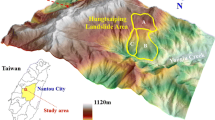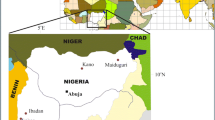Abstract
We present an integrated approach to investigate the seismically triggered Madison Canyon landslide (volume = 20 Mm3), which killed 26 people in Montana, USA, in 1959. We created engineering geomorphological maps and conducted field surveys, long-range terrestrial digital photogrammetry, and preliminary 2D numerical modelling with the objective of determining the conditioning factors, mechanisms, movement behaviour, and evolution of the failure. We emphasise the importance of both endogenic (i.e. seismic) and exogenic (i.e. geomorphic) processes in conditioning the slope for failure and hypothesise a sequence of events based on the morphology of the deposit and seismic modelling. A section of the slope was slowly deforming before a magnitude-7.5 earthquake with an epicentre 30 km away triggered the catastrophic failure in August 1959. The failed rock mass rapidly fragmented as it descended the slope towards Madison River. Part of the mass remained relatively intact as it moved on a layer of pulverised debris. The main slide was followed by several debris slides, slumps, and rockfalls. The slide debris was extensively modified soon after the disaster by the US Army Corps of Engineers to provide a stable outflow channel from newly formed Earthquake Lake. Our modelling and observations show that the landslide occurred as a result of long-term damage of the slope induced by fluvial undercutting, erosion, weathering, and past seismicity, and due to the short-term triggering effect of the 1959 earthquake. Static models suggest the slope was stable prior to the 1959 earthquake; failure would have required a significant reduction in material strength. Preliminary dynamic models indicate that repeated seismic loading was a critical process for catastrophic failure. Although the ridge geometry and existing tension cracks in the initiation zone amplified ground motions, the most important factors in initiating failure were pre-existing discontinuities and seismically induced damage. Amplification played a secondary role.



















Similar content being viewed by others
References
Alzo’ubi AM (2009) The effect of tensile strength on the stability of rock slopes. PhD thesis, University of Alberta, Edmonton
Ashford SA, Sitar N, Lysmer J, Deng N (1997) Topographic effects on the seismic response of steep slopes. Bull Seismol Soc Am 87:701–709
Bell FG (1994) Engineering properties of soils and rocks, 4th edn. Blackwell Science, Oxford
Bourdeau C, Havenith H-B (2008) Site effects modelling applied to the slope affected by the Suusamyr earthquake (Kyrgyzstan, 1992). Eng Geol 97:126–145
British Standards Institute (2015) Description of soils and rocks, BS 5930. In: Code of practice for ground investigations. BSI Standards Limited, London
Brunsden D, Doornkamp JC, Fookes PG, Jones DKC, Kelly JHM (1975) Large-scale geomorphological mapping and highway engineering design. Q J Eng Geol 8:227–253
Burjanek J, Edwards B, Faeh D (2014) Empirical evidence of local seismic effects at sites with pronounced topography: a systematic approach. Geophys J Int. doi:10.1093/gji/ggu014
Damjanac B, Varun Lorig L (2013) Seismic stability of large open pit slopes and pseudo-static analysis. In: Dight PM (ed) Slope stability 2013. Australian Centre for Geomechanics, Perth, pp 1203–1216
de la Montagne J (1960) Geomorphic problems in the Madison Valley, Madison County, Montana: an introduction and synthesis. 11th annual field conference: West Yellowstone-Earthquake Area. Billings Geological Society, pp 165–169
Del Gaudio V, Wasowski J (2011) Advances and problems in understanding the seismic response of potentially unstable slopes. Eng Geol 122:73–83
Doornkamp JC, Brunsden D, Jones DKC, Cooke RU, Bush PR (1979) Rapid geomorphological assessments for engineering. Q J Eng Geol 12:189–214
Doser DI (1985) Source parameters and faulting processes of the 1959 Hebgen Lake, Montana, earthquake sequence. J Geophys Res 90:4537–4555
Fookes PG, Lee EM, Milligan G (eds) (2005) Geomorphology for engineers. Whittles Publishing, Caithness
Fookes PG, Lee EM, Griffiths JS (2007) Engineering geomorphology: theory and practice. Whittles Publishing, Caithness
Gao F (2013) Simulation of failure mechanisms around underground coal mine openings using discrete element modelling. PhD thesis, Department of Earth Sciences, Simon Fraser University, Burnaby
Geological Society Engineering Group Working Party (1977) The description of rock masses for engineering purposes. Q J Eng Geol 10:355–388
Geological Society of London (1982) Working party report on land surface evaluation for engineering purposes. Q J Eng Geol 15:265–328
Gerber E, Scheidegger AE (1969) Stress-induced weathering of rock masses. Eclogae Geol Helv 62:401–415
Giardino JR, Marston RA (1999) Engineering geomorphology: an overview of changing the face of earth. Geomorphology 31:1–11
Gischig V, Eberhardt E, Moore JR, Hungr O (2015a) On the seismic response of deep-seated rock slope instabilities—insights from numerical modelling. Eng Geol 193:1–18
Gischig V, Preisig G, Eberhardt E (2015b) Numerical investigation of seismically induced rock mass fatigue as a mechanism contributing to the progressive failure of deep-seated landslides. Rock Mech Rock Eng. doi:10.1007/s00603-015-0821-z
Griffiths JS, Whitworth M (2012) Engineering geomorphology of landslides. In: Clague JJ, Stead D (eds) Landslides: types, mechanisms and modelling. Cambridge University Press, New York, pp 172–186
Griffiths JS, Stokes M, Stead D, Giles D (2012) Landscape evolution and engineering geology: results from IAEG Commission 22. Bull Eng Geol Environ 71:605–636
Hadley JB (1964) Landslides and related phenomena accompanying the Hebgen Lake earthquake of August 17, 1959. US Geol Surv Prof Pap 435:107–138
Hadley JB (1978) Madison Canyon rockslide, Montana, USA. In: Voight B (ed) Rockslides and avalanches, 1. Elsevier Scientific Publishing, Amsterdam, pp 172–180
Harp EL, Jibson RW (2002) Anomalous concentrations of seismically triggered rock falls in Pacoima Canyon: are they caused by highly susceptible slopes or local amplification of seismic shaking? Bull Seismol Soc Am 92:3180–3189
Havaej M, Wolter A, Stead D (2015) The possible role of brittle rock fracture in the 1963 Vajont Slide, Italy. Int J Rock Mech Min Sci 78:319–330
Havenith H-B, Strom A, Jongmans D, Abdrakhmatov K, Delvaux D, Trefois P (2003a) Seismic triggering of landslides, part A: field evidence from the northern Tien Shan. Nat Hazards Earth Sys Sci 3:135–149
Havenith H-B, Vanini M, Jongmans D, Faccioli E (2003b) Initiation of earthquake-induced slope failure: influence of topographical and other site specific amplification effects. J Seismolog 7:397–412
Hoek E, Brown ET (1997) Practical estimates of rock mass strength. Int J Rock Mech Min Sci 34:1165–1186
Hoek E, Kaiser PK, Bawden WF (1995) Support of underground excavations in hard rock. A.A Balkema, Rotterdam
Hoek E, Hutchinson J, Kalenchuk K, Diederichs M (2011) Appendix 3: Influence of in situ stresses on open pit design. In: Read J, Stacey P (eds) Guidelines for open pit slope design. CSIRO Publishing, Collingwood, pp 437–445
Itasca (2014) UDEC (v. 6.0). Itasca Consulting Group, Minneapolis
Jibson RW (2009) Using landslides for paleoseismic analysis. In: McCalpin JP (ed) Paleoseismicity, 2nd edn. Academic, New York, pp 565–601
Jibson RW, Rathje EM, Jibson MW, Lee YW (2014) SLAMMER—Seismic Landslide Movement Modeled using Earthquake Records (v. 1.1). US Geological Survey Techniques and Methods, Book 12, Chapter B1, unpaged
Kalenchuk KS, Diederichs MS, McKinnon S (2006) Characterizing block geometry in jointed rockmasses. Int J Rock Mech Min Sci 43:1212–1225
Kazerani R, Zhao J (2010) Micromechanical parameters in bonded particle method for modelling of brittle material failure. Int J Numer Anal Meth Geomech 34:1877–1895
Kent PE (1966) The transport mechanism in catastrophic rock falls. J Geol 74:79–83
Lee EM, Griffiths JS, Fookes PG (2004) Engineering geology: geomorphology. Encycl Geol 1:474–481
Leith KJ (2012) Stress development and geomechanical controls on the geomorphic evolution of alpine valleys. Dissertation, ETH Zürich, Zürich
Marinos P, Hoek E (2000) GSI: a geologically friendly tool for rock mass strength estimation. Proceedings of the GeoEng2000 at the international conference on geotechnical and geological engineering, Melbourne. Technomic Publishers, Lancaster, pp 1422–1446
Meunier P, Hovius N, Haines JA (2007) Regional patterns of earthquake-triggered landslides and their relation to ground motion. Geophys Res Lett 34:5
Meunier P, Hovius N, Haines JA (2008) Topographic site effects and the location of earthquake induced landslides. Earth Planet Sci Lett 275:221–232
Moore JR, Gischig V, Burjanek J, Löw S, Fäh D (2011) Site effects in unstable rock slopes: dynamic behaviour of the Randa instability (Switzerland). Bull Seismol Soc Am 101:3110–3116
Moore JR, Gischig V, Amann F, Hunziker M, Burjanek J (2012) Earthquake-triggered rock slope failures: damage and site effects. In: Eberhardt E, Froese C, Turner K, Leroueil S (eds) Landslides and engineered slopes. Taylor and Francis Group, London, pp 869–875
Murphy W, Mankelow JM (2004) Obtaining probabilistic estimates of displacement on a landslide during future earthquakes. J Earthq Eng 8:133–157
Murphy W, Petley DN, Bommer J, Mankelow JM (2002) Uncertainty in ground motion estimates for the evaluation of slope stability during earthquakes. Q J Eng Geol Hydrol 35:71–78
Rocscience (2013) RocData (v. 4.0). Rocscience Inc., Toronto
Saygili G, Rathje EM (2009) Probabilistically based seismic landslide hazard maps: an application in Southern California. Eng Geol 109:183–194
Sepúlveda SA, Murphy W, Jibson RW, Petley DN (2005) Seismically induced rock slope failures resulting from topographic amplification of strong ground motions: the case of Pacoima Canyon, California. Eng Geol 80:336–348
Shea T, van Wyk de Vries B (2008) Structural analysis and analogue modelling of the kinematics and dynamics of rockslide avalanches. Geosphere 4:657–686
Shelden AW (1960) Cenozoic faults and related geomorphic features in the Madison Valley, Montana. 11th Annual Field Conference: West Yellowstone-Earthquake Area, pp 178-184
Shugar DH, Clague JJ (2011) The sedimentology and geomorphology of rock avalanche deposits on glaciers. Sedimentology 58:1762–1783
Sturzenegger M (2010) Multi-scale characterisation of rock mass discontinuities and rock slope geometry using terrestrial remote sensing techniques. PhD thesis, Department of Earth Sciences, Simon Fraser University, Burnaby
Trunk FJ, Dent JD, Lang TE (1986) Computer modelling of large rock slides. J Geotech Eng 112:348–360
Wasowski J, Keefer DK, Lee C (2011) Toward the next generation of research on earthquake-induced landslides: current issues and future challenges. Eng Geol 122:1–8
Whalley WB (1974) The mechanics of high-magnitude, low-frequency rock failure and its importance in mountainous areas. Geographical Papers, University of Reading, Reading, pp 27–48
Wolter A (2014) Characterisation of large catastrophic landslides using an integrated field, remote sensing and numerical modelling approach. PhD thesis, Department of Earth Sciences, Simon Fraser University, Burnaby
Acknowledgments
The authors gratefully acknowledge the comments and advice of two reviewers and the help of the US Forest Service, particularly Joanne Girvin. Diane Doser supplied seismogram records. Camille Christiansen and Jeanette Klassen assisted in the field. Brent Ward helped with the air photograph analysis. The US Geological Survey provided imagery. Research was funded through an NSERC scholarship to A. Wolter and NSERC Discovery Grants to D. Stead and J. J. Clague.
Author information
Authors and Affiliations
Corresponding author
Rights and permissions
About this article
Cite this article
Wolter, A., Gischig, V., Stead, D. et al. Investigation of Geomorphic and Seismic Effects on the 1959 Madison Canyon, Montana, Landslide Using an Integrated Field, Engineering Geomorphology Mapping, and Numerical Modelling Approach. Rock Mech Rock Eng 49, 2479–2501 (2016). https://doi.org/10.1007/s00603-015-0889-5
Received:
Accepted:
Published:
Issue Date:
DOI: https://doi.org/10.1007/s00603-015-0889-5




